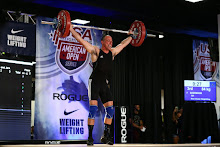My sports med doc said that though this was obviously a serious diagnosis, that it was a "stable" spondy (I had flexion/extension x-rays done to confirm it was "stable" and not experiencing excessive segmental motion) and that much of the research shows that spondy's don't tend to increase in slippage without a major trauma, so I didn't necessarily need to worry too much at this point. Now, every case is unique, and obviously the nerve was pretty compressed, but he didn't think that the nerve pain and numbness would necessarily progress unless there was a major trauma. He thought that ultimately I should be able to return to doing the kinds of activities that I like to do assuming I could get the nerve pain calmed down. He suggested some initial rest and some PT to see if we could calm down the nerve pain. This seemed like a reasonable approach to take, so I stopped CrossFitting at the end of July, and went ahead and scheduled PT to begin in August.
Of course, being a research nerd and a CrossFitter, after my diagnosis and during my rest, I started scouring the net for information on the condition and what the best course of action would be beyond PT. I wanted to know about the risks of doing CrossFit, lifting, playing sports, etc. with a spondy and degenerative disc, and whether I would make things worse. It was (and is) hard to find great info on spondy and weightlifting, Crossfit, etc. but I did find a few posts here and there, some conflicting and some in agreement. Mark Rippetoe, of Starting Strength fame, seems to suggest that lifting can be very helpful for those with spondy in terms of maintaining core and overall strength (obviously while maintaining strict form), and Kelly Starrett also suggests that those with spondy can continue to lift, assuming they stay primarily to "stable" category 1 movements (squats, deadlifts, push ups, pullups, etc.) as well. So, there was some encouraging news there, but obviously disappointing in the fact that going hard with Oly movements might not be the best idea going forward.
Throughout my searches, I kept coming across info by Stuart McGill, a PhD from Waterloo, Canada, who is regarded as an expert in the field of spinal research. He has conducted dozens of experiments to determine the effects of various types of loading on the structure of the spine and his conclusions and recommendations for improving core/spinal stiffness have been used and shared widely. In short, McGill is a big proponent of maintaining spinal stiffness (i.e. no relative lumbar motion) in athletic endeavors (which CrossFit also prescribes in pretty much all movements) and doesn't like movements that emphasize spinal power, especially loaded flexion (think rounded back deadlifts) or repetitive flexion/extension movements like sit-ups, back extensions, toes-to-bar, knees-to-elbows, etc. due to risk of disc damage. Now, how much of that repetitive motion disc damage applies to those with spondy is a question I don't have an answer to, but I've taken McGill's notion of spinal stiffness to heart with a vengeance, since it seems to minimize risk of further damage, and I try to apply it to all of my movements. Indeed, I had found that many of the sit-up and back extension movements were irritating to the nerve in my case so I've stopped doing those.
As far as sports go, I did come across a few folks who have reported continuing to play their sports with spondy (most notably, Steve Nash of NBA fame) so that seemed reasonable as long as I could get the pain under control and maintain core stiffness.
With all this in mind, I moved into August of 2013 determined to decrease the pain and build up the necessary strength and skills needed to ensure that I could go back to doing what I wanted. I began August by resting completely for a couple of weeks, and then began a formal PT program. PT at first involved some massage and mobilization of the lower back muscles, pelvis, quadriceps and hamstrings, as well as some attempts at mobilization of the nerve itself using "flossing" technique (as described by McGill), and then we progressed into core strengthening work including bird-dogs, glute bridges, clamshells, etc. I discovered some core weaknesses that I had despite CrossFitting 4-5 days/week (especially in the gluteus medius), and got an opportunity to really work on those. Unfortunately, though I initially saw a bit of decrease in pain levels, it wasn't a major improvement, and I was beginning to get a bit discouraged by the lack of progress. I continued on the path for another 5-6 weeks hoping that things would get better.
Up next: After PT
#crossfit #weightlifting #spondylolisthesis

Have you seen any more improvement in the pain since continuing the cross fit? Do you still crossffit? How do you modify the workouts?
ReplyDeleteThanks for your comment and my apologies for not updating the blog in a while. Will post another update shortly.
ReplyDeleteIn short, I saw no improvement in my pain through conservative treatments and had a decompression procedure done last fall and am back to CrossFit. I do modify some WOD's either for weight or for movements. I sub things like KB swings for hi-rep snatches, rowing on damper of 10 for hi-rep deadlifts, etc. I will post more in an upcoming update.
Hi -
ReplyDeleteWhat was the decompression treatment & who did it?
My procedure is described in this (later) post:
Deletehttp://cfspondy.blogspot.com/2015/03/
It was done by Dr. William Welch at UPenn.